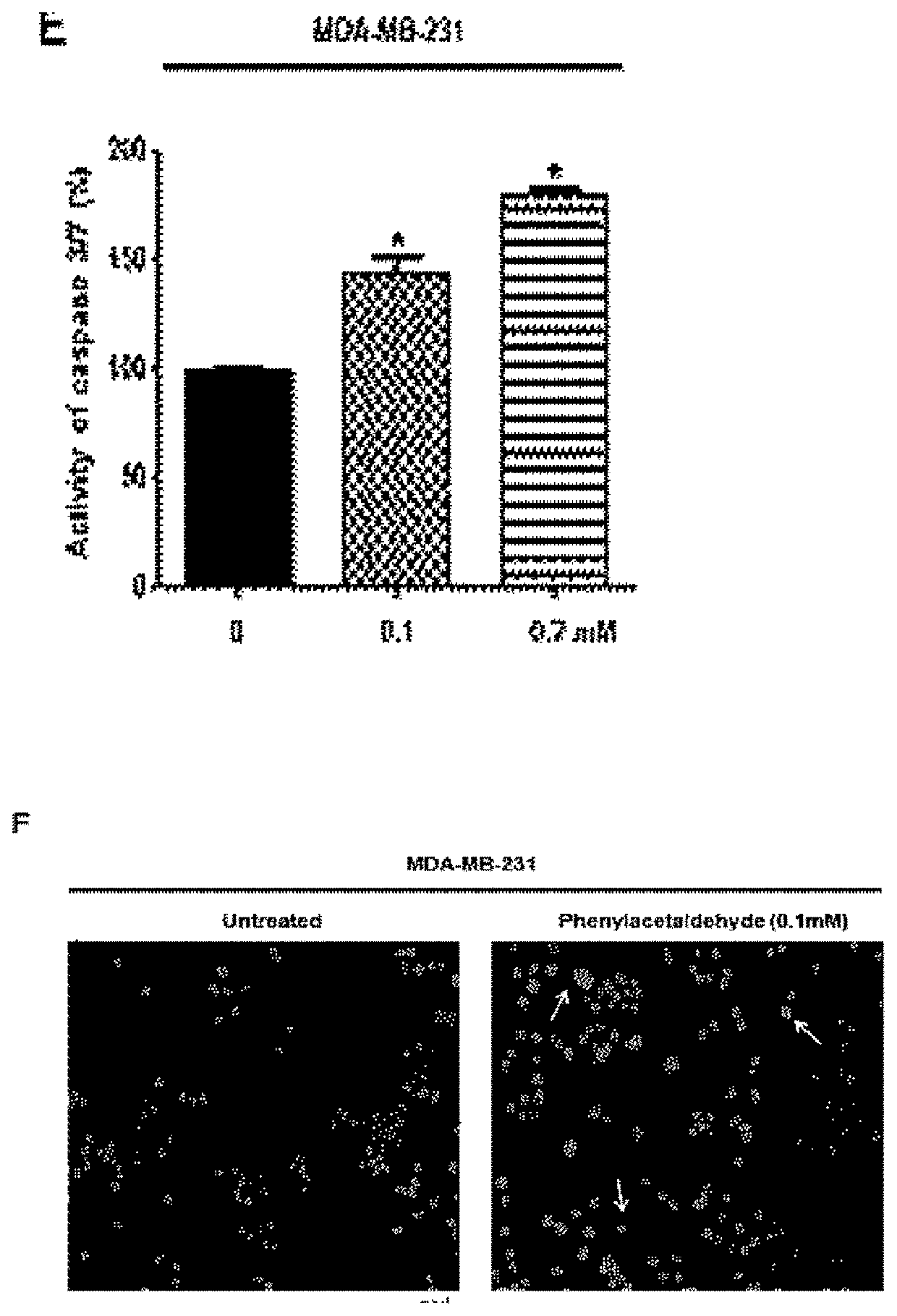Composition for inhibiting growth of breast cancer stem cells containing phenylacetaldehyde
a technology of phenylacetaldehyde and which is applied in the field of compositions for can solve the problems of cancer recurrence and metastasis, poor prognosis, and resistance to conventional chemotherapy, and achieve the effects of inhibiting the growth of breast cancer stem cells, and inhibiting the stats signaling pathway
- Summary
- Abstract
- Description
- Claims
- Application Information
AI Technical Summary
Benefits of technology
Problems solved by technology
Method used
Image
Examples
example 1
rial
[0145]6- and 24-well culture plates including very low-attachment cluster plates were commercially available from Corning (Tewksbury, Mass., USA). A perfume compound containing phenylacetaldehyde was purchased from Sigma-Aldrich Co. (St. Louis, Mo., USA). Cell viability was measured using a CellTiter 96® aqueous one solution cell proliferation assay kit (Promega, Madison, Wis., USA). An ALDEFLUOR™ Kit was purchased from STEMCELL Technologies Inc (Vancouver, BC, Canada). For example, a chemical reagent such as doxorubicin was purchased from Sigma-Aldrich Co. (St. Louis, Mo., USA).
example 2
f Human Breast Cancer Cells and Formation of Mammospheres
[0146]Human breast cancer cells, i.e., MCF-7 and MDA-MB-231, were commercially obtained from American Type Culture Collection (ATCC; Manassas, Va., USA). MCF-7 and MDA-MB-231 cells were cultured in Dulbecco's modified essential medium (DMEM; Hyclone, Logan, Utah, USA) containing 10% fetal bovine serum (FBS; Hyclone), 100 U / mL of penicillin, and 100 μg / mL of streptomycin (Hyclone). The MCF-7 and MDA-MB-231 cells were maintained at 37° C. in a 5% CO2-containing humidified incubator. The cells were plated at a density of 1×106 on a 10 cm petri dish. In order to establish primary mammospheres, single cell-suspended MCF-7 and MDA-MB-231 cells were seeded at a density (cells / well) of 3.5×104 to 4×104 and 0.5×104 to 1×104, respectively, on ultra-low attachment 6-well plates containing 2 ml complete MammoCult™ medium (StemCell Technologies, Vancouver, BC, Canada). The complete MammoCult™ medium was supplemented with 4 μg / mL of heparin...
example 3
Calculation of Mammospheres
[0147]At 7 days of culture, the cell culture plate was disposed on a scanner (Epson Perfection V700 PHOTO, Epson Korea, Co, Seoul, Korea) to obtain an 8 bit gray scale image of mammospheres. The image was obtained at a low resolution (300 dpi) using an NICE software program and downloaded from ftp: / / ftp.nist.gov / pub / physics / mLclarke / NICE. For counting, preferred numbers of rows and columns (for example, 2×3 of 6-well plate) were selected to form regions of interest (ROIs), and an oval setting of the NICE program was selected and then respective ROIs were defined by moving the shapes of provided ROIs and controlling the sizes thereof. The background signal of the image was negated using a critical algorithm and the selected image was automatically counted. Regarding the mammosphere formation analysis, formation efficiency of mammospheres (MFE, %) was determined in accordance with the number of mammospheres per well / the total number of cells plated per well×...
PUM
| Property | Measurement | Unit |
|---|---|---|
| Volatility | aaaaa | aaaaa |
Abstract
Description
Claims
Application Information
 Login to View More
Login to View More - R&D
- Intellectual Property
- Life Sciences
- Materials
- Tech Scout
- Unparalleled Data Quality
- Higher Quality Content
- 60% Fewer Hallucinations
Browse by: Latest US Patents, China's latest patents, Technical Efficacy Thesaurus, Application Domain, Technology Topic, Popular Technical Reports.
© 2025 PatSnap. All rights reserved.Legal|Privacy policy|Modern Slavery Act Transparency Statement|Sitemap|About US| Contact US: help@patsnap.com



